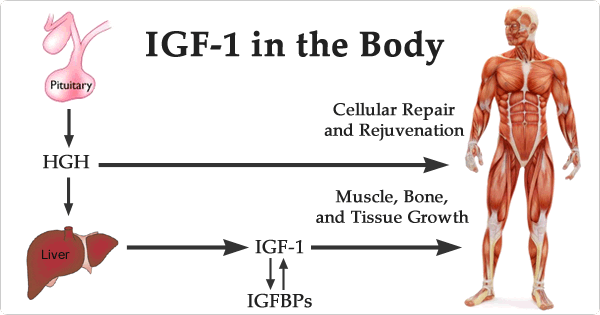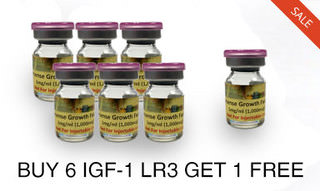IGF-1 lr3 Dosage and Duration Guide
IGF-1 and Questions
What is IGF-1?
What is IGF-1 Lr3?
How much IGF-1 Lr3 should be used?
How long should IGF-1 Lr3 be used?
See below for the answers to the above questions
What is IGF-1?
IGF-1 is a polypeptide hormone about the same size as insulin, or 70 amino acids. It´s a highly anabolic hormone released primarily in the liver (but also in peripheral tissues) and stimulates the production of growth hormone. It is responsible for much of the anabolic activity of growth hormone, including nitrogen retention and protein synthesis as well as muscle cell hyperplasia (increase in number of muscle cells), as well as mitogenesis (the growth of new muscle fibers).
IGF-1 is necessary as well as sufficient in muscle growth (anabolic) and has been shown to also be highly anti-catabolic agent as well. As with all anabolic substances, IGF-1´s anabolic effects are still limited only by the protein supply within muscle cells. Thus IGF works much better when enough protein is supplied to the muscle.
For athletes and bodybuilders who are rehabilitating an injury IGF is vital to the proper production of connective tissue, and studies have shown that exogenous IGF administration may improve collagen formation and aid in the repair of cartilage and would greatly decrease recovery time as well as increase the strength of the recovered area.
A study examined the injection of insulin-like growth factor I (IGF-I) in different muscle fibers. The researchers concluded that IGF-I promotes an average increase of 15% in muscle mass and a 14% increase in strength in muscle tissue. The researchers have speculated that these effects are primarily due to stimulation of muscle regeneration via the activation of satellite cells by IGF-I.
A 15% increase in muscle mass, and a 14% increase in strength are no small increases. If we could realistically expect 7% gains in muscle mass and strength (half of the gains experienced in the study), then this would be able to help through plateaus or injuries.
What is IGF-1 Lr3?
IGF-1 Lr3 (Insulin-like Growth Factor-I Long R3) is an 83 amino acid analog of human IGF-I comprising the complete human IGF-I sequence with the substitution of an Arg for the Glu at position 3 (hence R3), as well as a 13 amino acid extension peptide at the N-terminus. IGF-I Lr3 is significantly more potent (2-3x) than IGF-I in studies, because it has a lower affinity to be rendered inactive by IGF binding proteins.
What is a typical protocol for IGF-1 Lr3?
Studies have suggested the following:
A typical protocol would be:
50-100mcg of IGF-1 Lr3 divided into 1-2 bilateral administrations in 2-5 different areas of the muscles approximately 5-7 days a week – intramuscular injections.
Example, if you want to administer 100mcg of IGF-1 Lr3 into the chest in 2 different areas of the muscle then you would need to divided the dose as follows:
100mcg per administration / 2 chest muscles = 50mcg per muscle
50mcg per muscle / 2 different locations on each muscle = 25mcg per injection
Theoretically, the more locations used to administer the IGF-1 Lr3 into the muscle the more places for muscle growth.
Studies have also suggested the following:
Administration should not be given within 2 hours after training in order not to reduce natural IGF-1 production.
Administration should not be given within 2 hours before sleeping in order not to reduce natural growth hormone production.
After administering, adequate protein needs to be ingested for IGF-1 to be effective in building new muscle.
How long should IGF-1 Lr3 be used?
In most studies on IGF-1 Lr3 no adverse side effects were reported with use for 4-8 weeks (per the dosage limits in the above answer) followed by 4 weeks of non-use.


